Ever wonder why homemade mayonnaise always wins over the jarred variety? Once you’ve tried it, you’ll see what all the fuss is about. This silky, flavorful condiment isn’t just fresher—it’s entirely tailored to your tastes. From a classic tang to zesty garlic or spicy undertones, the possibilities are endless.
Crafting your own mayo is easier than you think. With just a handful of kitchen staples, you’ll whip up a velvety, perfectly blended spread that elevates everything from sandwiches to dressings. Plus, you’ll enjoy a cleaner ingredient list—no preservatives or additives, just pure, homemade goodness.
Print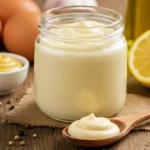
Homemade Mayonnaise – Rich, Creamy, and Easy to Make
- Total Time: 5 minutes
- Yield: 1 cup (about 16 tablespoons)
- Diet: Gluten Free
Description
This homemade mayonnaise is incredibly rich, smooth, and packed with fresh flavor. Made with simple ingredients like eggs, mustard, lemon juice, and oil, it creates a creamy, tangy condiment perfect for sandwiches, dips, and dressings. Unlike store-bought mayo, this version is free from preservatives and fully customizable to your taste. Once you try making it from scratch, you’ll never go back!
Ingredients
- 1 large egg (room temperature)
- 1 cup neutral oil (avocado, sunflower, or light olive oil)
- 1 tablespoon lemon juice (or white wine vinegar)
- 1 teaspoon Dijon mustard
- 1/2 teaspoon salt
- 1/2 teaspoon honey or sugar (optional, for a hint of sweetness)
Flavor Variations:
- Garlic Aioli: Add 1 minced garlic clove
- Spicy Mayo: Mix in 1 teaspoon sriracha or chipotle powder
- Herb Mayo: Stir in 1 teaspoon fresh chopped parsley or chives
Instructions
Prepare Ingredients
- Ensure all ingredients are at room temperature for proper emulsification.
Start the Emulsion
- In a tall jar or mixing bowl, combine the egg, mustard, lemon juice, and salt.
- If using a blender or immersion blender, pulse the ingredients for a few seconds to mix.
Slowly Add the Oil
- With the blender running on low speed, slowly drizzle in the oil in a thin, steady stream.
- If whisking by hand, whisk continuously while adding the oil drop by drop at first, then gradually increasing.
Blend Until Thick and Creamy
- Continue blending or whisking until the mayonnaise thickens to a smooth, creamy consistency.
- If the mayo is too thick, stir in a teaspoon of water to adjust the texture.
Taste and Adjust
- Add more salt or lemon juice if needed.
- Transfer to an airtight container and refrigerate immediately.
Notes
- Storage: Keep in an airtight container in the refrigerator for up to 7 days.
- Fixing Separated Mayo: If your mayo breaks, start with a fresh egg yolk in a clean bowl and slowly whisk in the broken mixture.
- Oil Choice Matters: Avoid strong-flavored oils like extra virgin olive oil, as they can make the mayo bitter.
- Prep Time: 5 minutes
- Cook Time: 0 minutes
- Category: Condiment, Sauce
- Method: Emulsified
- Cuisine: French, American
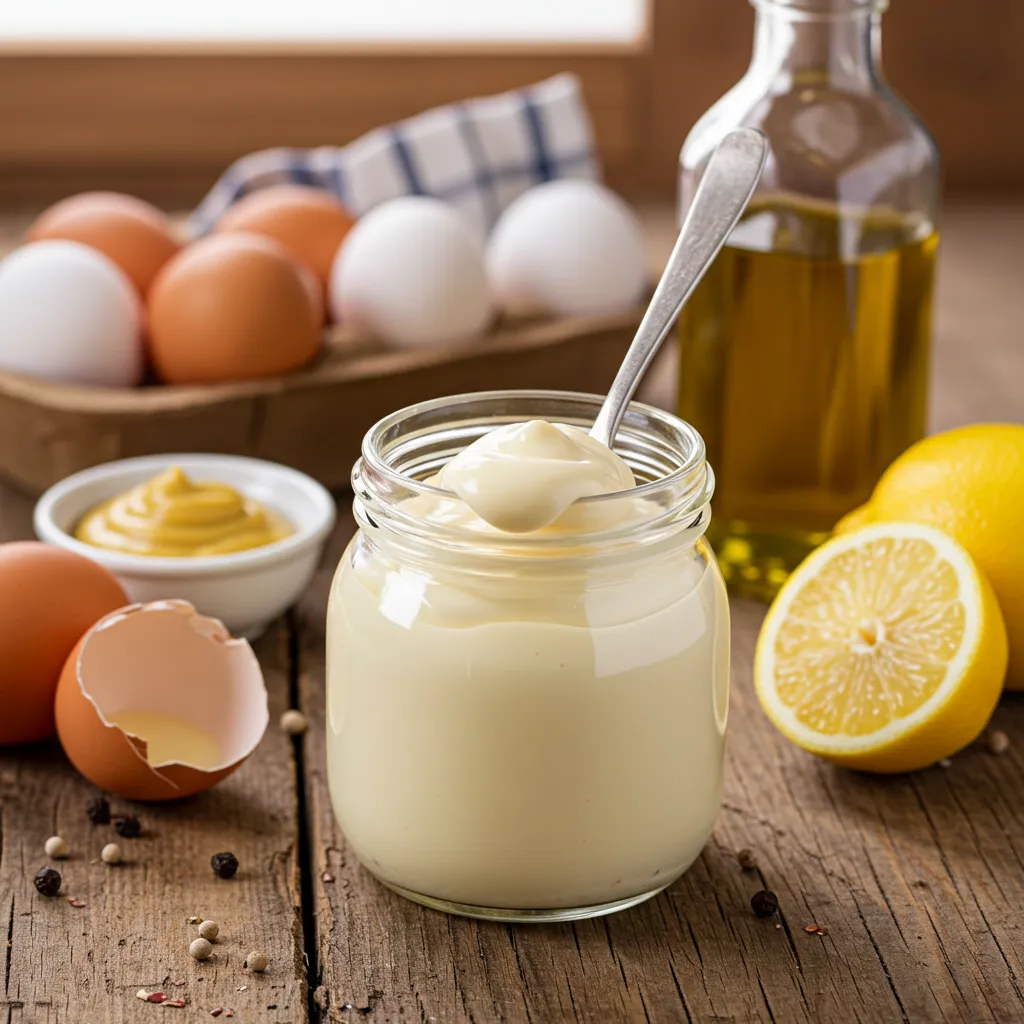
Why You’ll Love This Homemade Mayonnaise Recipe
Once you whip up a batch of homemade mayonnaise, you’ll never want to reach for the store-bought version again. The flavor is noticeably fresher, the texture irresistibly creamy, and best of all, you’re in full control of every ingredient that goes in. And that’s exactly what sets this recipe apart—it’s simple, flavorful, and made with love from start to finish.
Key Benefits of Making Mayo at Home
- Store-bought mayonnaise often includes preservatives and artificial additives. When you make it yourself, you’re using fresh, whole ingredients for a cleaner, more vibrant flavor that truly stands out.
- Homemade mayo delivers a rich, velvety consistency that’s hard to match. The magic happens when you combine high-quality ingredients with a foolproof emulsification technique. Need a quick refresher? Don’t miss this helpful guide to making perfect emulsions.
- Homemade mayo delivers a rich, velvety consistency that’s hard to match. The magic happens when you combine high-quality ingredients with a foolproof emulsification technique. Need a quick refresher? Don’t miss this helpful top chefs.
- Many commercial mayonnaises use refined oils and added sugars. When you go homemade, you get to pick nourishing options like avocado oil or extra virgin olive oil. Want to learn more? Check out this detailed healthy fats.
- No fancy tools needed—just a few simple pantry ingredients and a whisk or blender. In under five minutes, you’ll have fresh, delicious mayonnaise ready to use in your favorite dishes.
Better for Every Diet
Keto and Low-Carb
Skip the processed oils and opt for avocado or macadamia oil to create a mayo that fits seamlessly into your keto or low-carb lifestyle.
Naturally Dairy-Free
Mayonnaise is naturally free of dairy, making it an ideal choice for anyone with lactose intolerance or following a dairy-free diet.
Paleo and Whole30 Friendly
Keep it clean and compliant by using unprocessed oils and avoiding added sugars—perfect for paleo and Whole30 meal plans.
But this creamy mayo goes far beyond just sandwiches—it’s a versatile staple for dressings, dips, and so much more. It makes a delicious base for homemade salad dressings, savory dips, and flavorful marinades. Now that you know how versatile and diet-friendly it is, let’s take a look at the simple ingredients you’ll need to whip it up.
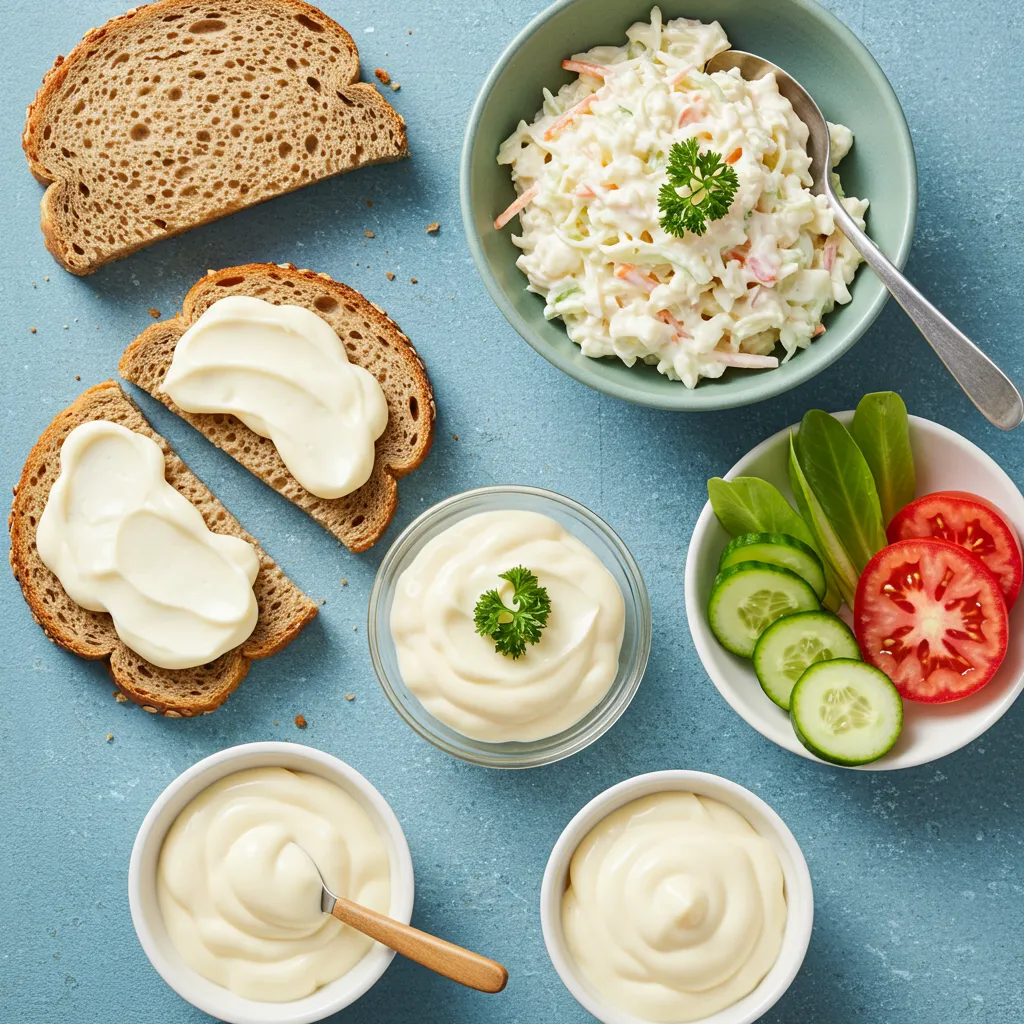
Ingredients for the Perfect Homemade Mayonnaise
Great mayonnaise begins with just a few simple, high-quality ingredients. When you strike the right balance between fat, acidity, and seasoning, you get that signature creamy texture and rich, tangy flavor that makes homemade mayo so irresistible. Here’s everything you’ll need to get started.
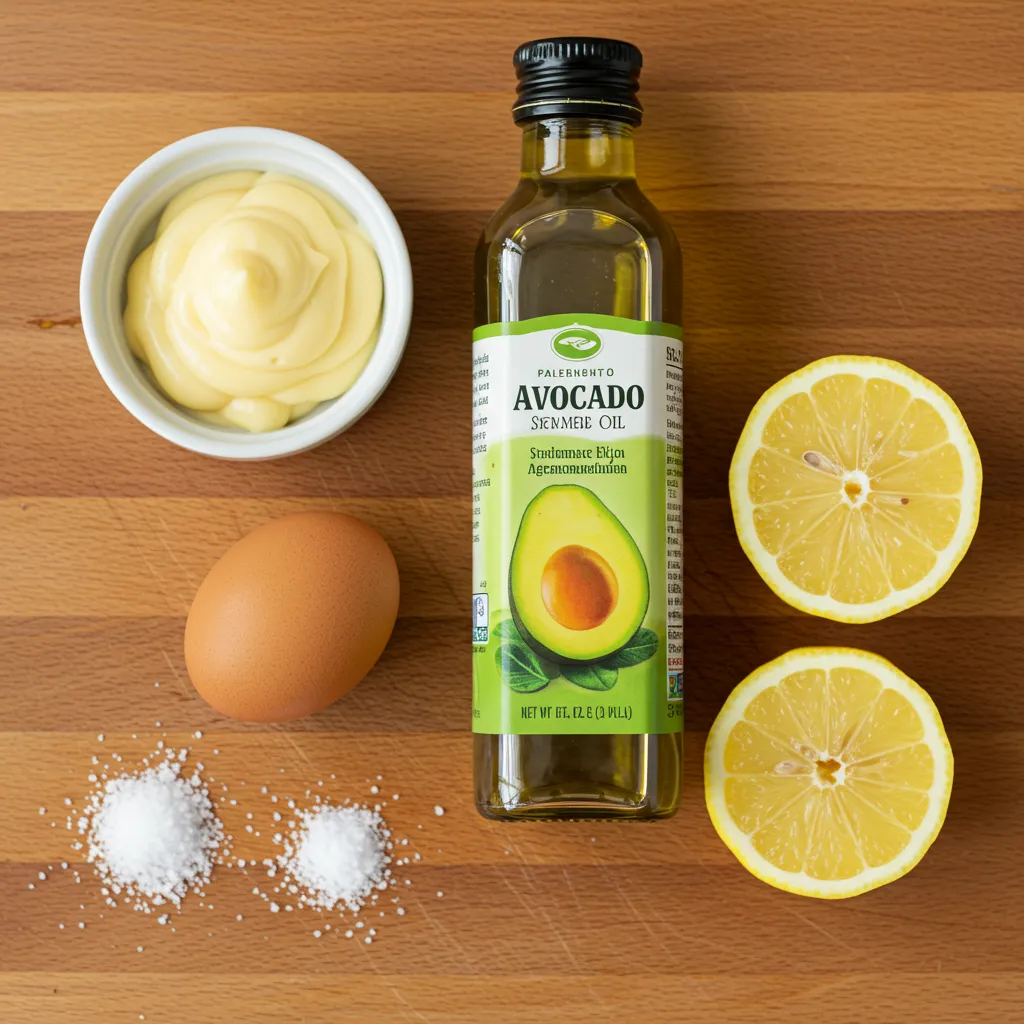
Essential Ingredients
- 1 large egg – The foundation of a stable emulsion. For the safest and creamiest results, always choose fresh, pasteurized eggs.
- 1 cup neutral oil – Choose a mild oil like avocado, sunflower, or light olive oil for a clean flavor. Steer clear of extra virgin olive oil—it can overpower the taste.
- 1 tablespoon lemon juice or vinegar – Brings a bright, tangy flavor and helps the emulsion form. White wine vinegar or apple cider vinegar work beautifully as flavorful options.
- 1 teaspoon Dijon mustard – Enhances the flavor and strengthens the emulsion. If needed, yellow mustard can be used as a substitute.
- 1/2 teaspoon salt – Enhances the overall taste. Fine sea salt blends in more easily than coarse varieties.
Optional Additions for Flavor
- 1/2 teaspoon honey or sugar – Gently balances the acidity with a subtle hint of sweetness.
- 1 small garlic clove (minced or grated) – For a subtle garlic aioli twist.
- 1/4 teaspoon white pepper – Adds gentle heat without changing the color of your mayo.
Ingredient Substitutions
- For a richer texture – Use only the egg yolk instead of the whole egg.
- For a dairy-free option – Stick to plant-based oils and explore egg substitutes if needed.
- For a lighter version – Try using half oil and half Greek yogurt for a tangy, lower-fat alternative.
Fresh, high-quality ingredients are the key to rich flavor and a perfectly smooth, creamy consistency. Now that your ingredients are ready, let’s walk through how to make perfect homemade mayonnaise step by step.
Step-by-Step Instructions for Perfect Homemade Mayonnaise
Making mayonnaise from scratch is easier than you might expect—and the results are so rewarding. The secret to success lies in slowly adding the oil to build a stable emulsion. Follow these simple steps to whip up silky, creamy mayonnaise every single time.
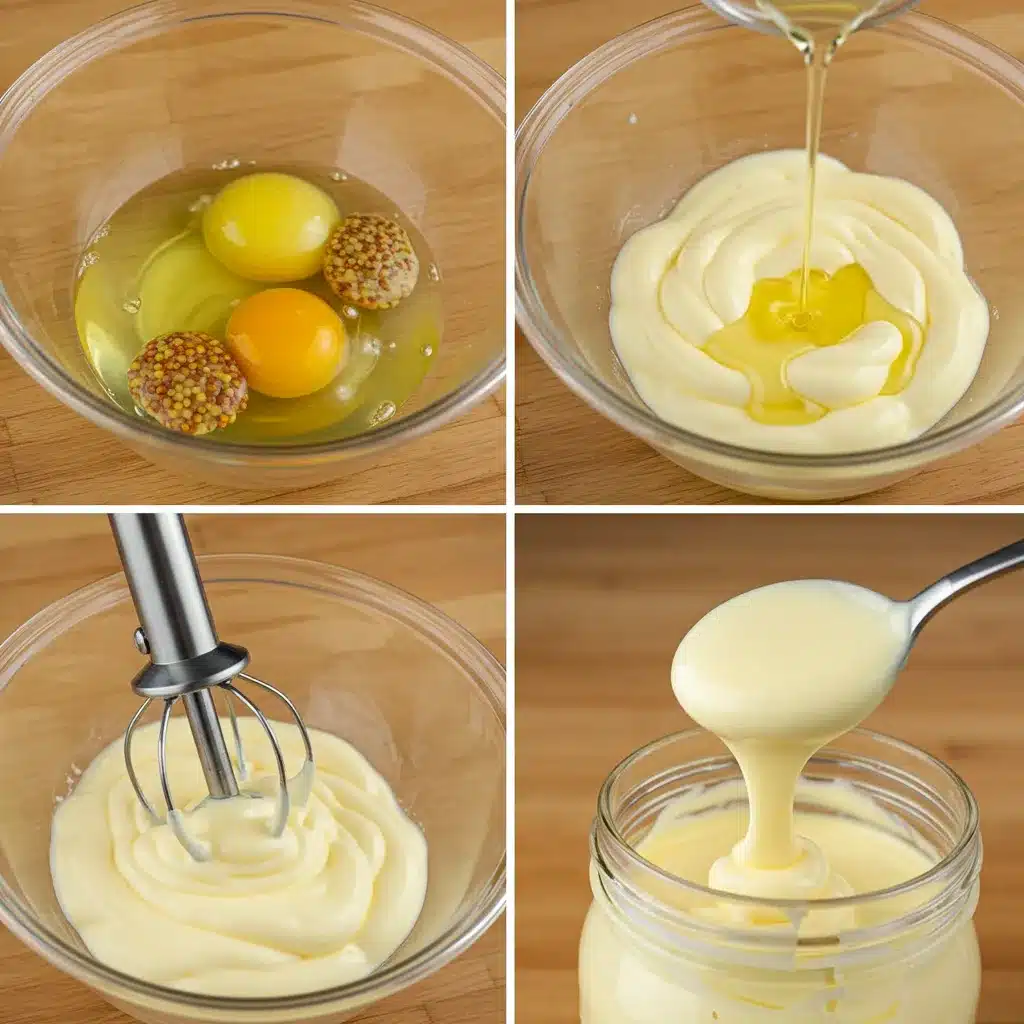
1. Prepare Your Ingredients
Be sure all your ingredients are at room temperature—it’s the key to a smooth, stable emulsion. This small step makes a big difference—it helps create a stable emulsion and prevents your mayo from separating.
2. Start the Emulsion
In a tall jar or mixing bowl, add the egg, lemon juice (or vinegar), , Dijon mustard, and salt
If you’re using a blender or food processor, give the mixture a quick pulse to fully blend the ingredients before slowly streaming in the oil.
3. Slowly Add the Oil
With the blender or food processor running on low speed, slowly drizzle in the oil—starting with just a few drops at a time to help the emulsion form properly.
As the mixture begins to thicken, slowly increase to a thin, steady stream of oil to maintain a smooth, stable emulsion.
If whisking by hand, go slow and steady, whisking constantly to keep the texture smooth.
4. Blend Until Creamy
Keep blending until the mayo becomes thick and creamy. This process typically takes 1–2 minutes with an immersion blender, or about 3–4 minutes when whisking by hand.
If the texture ends up too thick, simply stir in a teaspoon of water until it reaches your desired consistency.
5. Taste and Adjust
Give your mayo a taste and fine-tune the flavor. Add a pinch more salt, an extra splash of lemon juice for brightness, or a dash of white pepper for subtle heat and depth.
Troubleshooting Common Issues
- Mayo too thin?
No problem—just slowly whisk in a bit more oil. This helps bring back the thick, creamy texture you’re aiming for. - Mayo separated?
Don’t toss it! Start with a fresh egg yolk placed in a clean mixing bowl as the base for your emulsion., then slowly whisk in the separated mayo, one spoonful at a time, until it re-emulsifies into a smooth, creamy consistency. This will help bring it back together through re-emulsification. Too tangy?
A tiny pinch of sugar or a drizzle of honey can gently soften the acidity and bring the flavors into perfect balance.Once your mayo is silky smooth and beautifully emulsified, it’s ready to enjoy. Transfer it to an airtight container, refrigerate promptly, and use within one week for the freshest flavor.
Now that you’ve nailed the basics, let’s dive into some expert tips and creative flavor variations to make this homemade mayonnaise truly your own.
Serving Suggestions for Homemade Mayonnaise
Homemade mayonnaise is so much more than a simple sandwich spread. Its rich, velvety texture and bold, fresh flavor make it a versatile staple you’ll want to use in all kinds of dishes. Here are some delicious and creative ways to use your freshly made mayo in everyday meals.
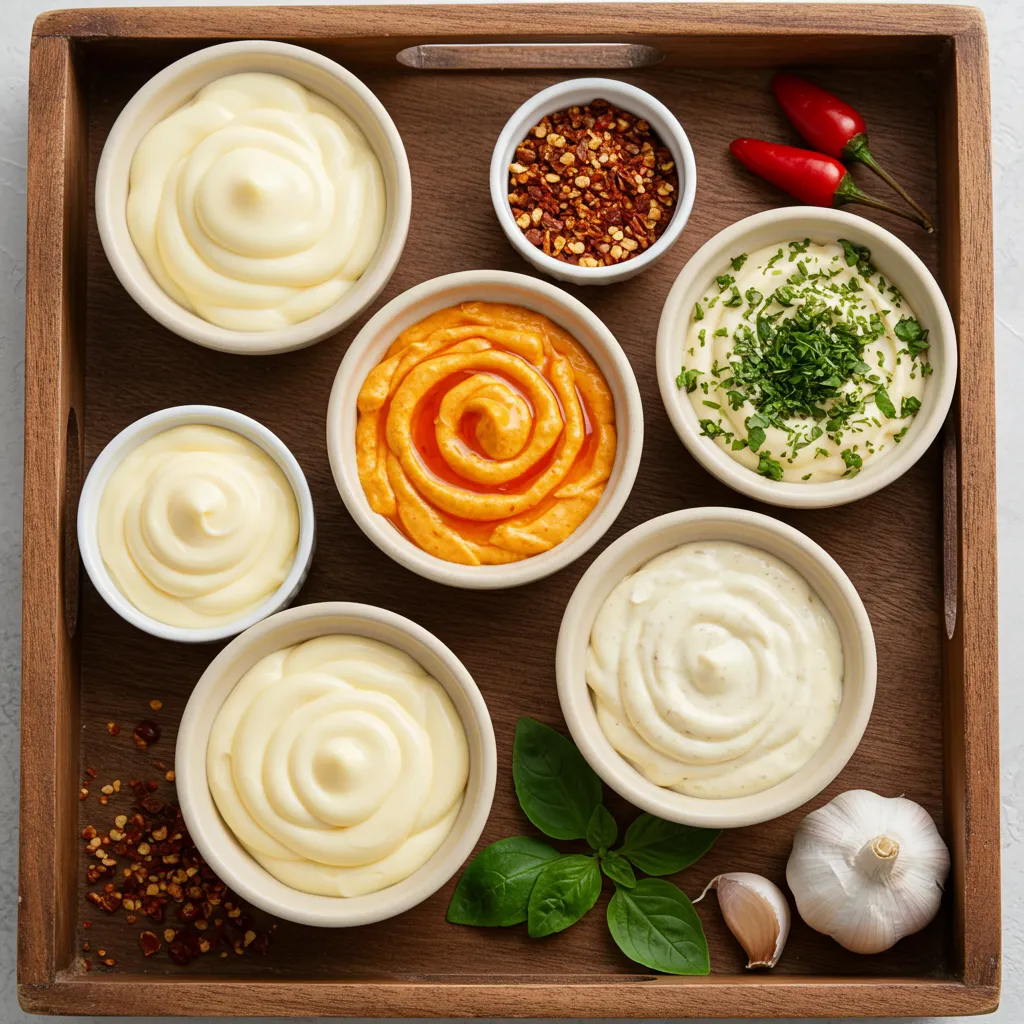
Perfect Pairings for Homemade Mayonnaise
Sandwiches & Wraps
Spread a generous layer onto fresh bread or tortillas to create a rich, flavorful base. It complements everything from deli meats and grilled chicken to roasted veggies.
Salad Dressings
Whisk mayonnaise with lemon juice, fresh herbs, or a splash of vinegar to create rich, creamy dressings—perfect for coleslaw, potato salad, or a homemade Caesar salad.
Dips & Sauces
Blend mayonnaise with garlic, hot sauce, or mustard for a quick, flavorful dip—perfect for pairing with fries, fresh veggies, or seafood. For a classic fry sauce, combine mayo with ketchup—it’s a crowd favorite.
Burgers & Sliders
Spread a thin layer of mayo on the bun before toasting—it locks in flavor and helps prevent sogginess for the perfect bite. It’s a simple trick that adds a lot of flavor.
Marinades & Coatings
Use mayo as a base for marinades—it helps seal in moisture and gives meats, fish, or veggies a tender, juicy texture when roasted or grilled.
Presentation Tips
Serve in a Small Bowl
A small serving bowl keeps your homemade mayo looking fresh and appetizing. Add a sprinkle of fresh herbs or a drizzle of olive oil on top for extra flair.
Use a Squeeze Bottle
Transfer your mayo to a clean squeeze bottle for easy, mess-free drizzling on wraps, tacos, or burgers. It’s great for tacos, wraps, and burgers, and makes plating a breeze.
Garnish for Appeal
Top with chopped parsley, fresh chives, or a dusting of smoked paprika to boost both flavor and visual appeal.
Storage & Freshness Tips
Refrigerate Right Away
Place your mayo in an airtight container and refrigerate it promptly at 40°F (4°C) or lower.
Use Within a Week
Since homemade mayo doesn’t contain preservatives, it’s best enjoyed within 5 to 7 days for maximum freshness and flavor.
Seal It Well
Keep the container tightly sealed to prevent the mayo from picking up other odors in the fridge.
Homemade mayonnaise is a simple yet powerful way to elevate your everyday cooking. Whether it’s the star of a sandwich or the base of a flavorful dip, its fresh, creamy texture makes every dish a little more special.
To finish up, here’s a quick recap and a few final thoughts to bring it all together.
Conclusion: Why This Homemade Mayonnaise Recipe Deserves a Spot in Your Kitchen
Homemade mayonnaise isn’t just a pantry essential—it’s a total flavor upgrade. With just a few basic ingredients, you can whip up a rich, creamy, and tangy spread that tastes far better than anything you’ll find on a store shelf.
It’s not only fast and foolproof to make, but also endlessly adaptable. From classic mayo to garlicky aioli or spicy twists, you can easily tailor it to your taste and dietary needs. Once you experience the freshness and versatility of homemade mayo, you’ll never look back
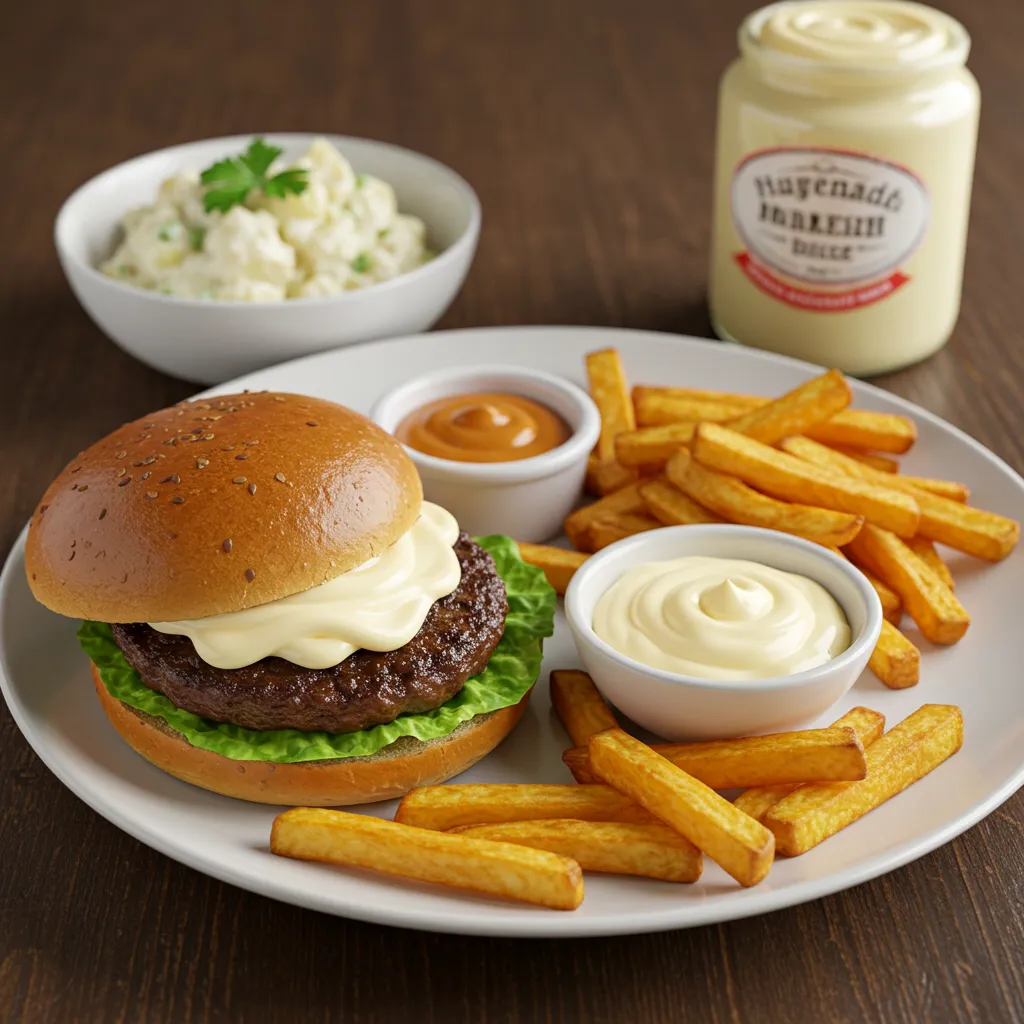
Explore More Recipes
Loved making your own mayo? Keep the inspiration flowing with these related recipes and kitchen tips to elevate your homemade creations.
- Why is Homemade Mayonnaise Not Advisable? – Discover common pitfalls and important food safety tips when making mayo at home.
- How to Make Mustard at Home – Learn how to craft your own mustard—an ideal companion to your homemade mayo.
- The Ultimate Guide to Truffle Hot Sauce – Give your dips and dressings a gourmet twist with the bold, rich flavor of this truffle hot sauce.
- Properly Storing Soy Sauce for Freshness and Longevity – Get the most out of your pantry staples by storing your soy sauce the right way.
- Porcupine Soup – A warm, comforting dish that pairs beautifully with rich, homemade condiments like mayo, mustard, or aioli.
Exploring homemade condiments like mayonnaise is an easy yet impactful way to add fresh, bold flavor to your everyday meals. Try it out and taste the difference—and if you do, be sure to share your delicious results!
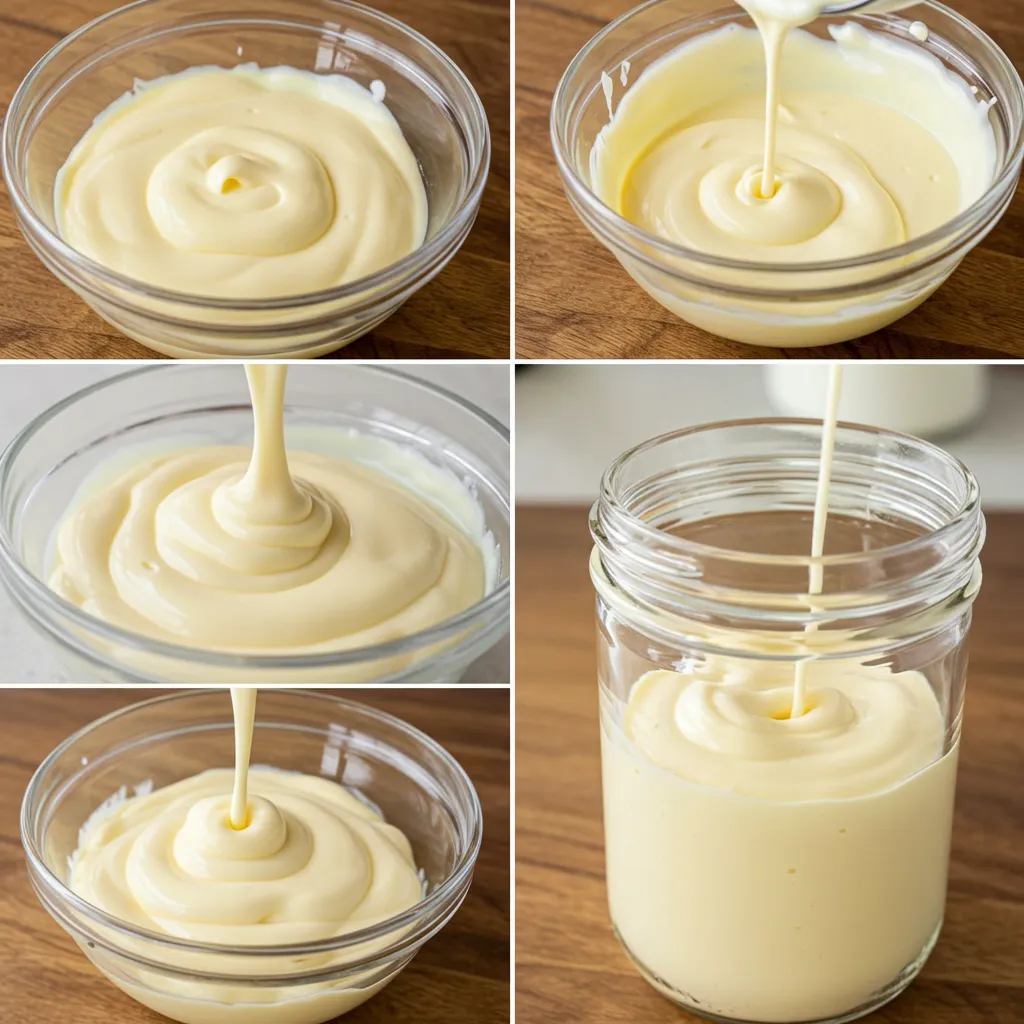
FAQs: Your Complete Guide to Homemade Mayonnaise
Making your own mayonnaise is easy, but if you’re just getting started, you might have a few questions along the way. Here are the most frequently asked questions—along with expert tips to help you nail the perfect homemade mayo every time.
1. Is It Possible to Make Homemade Mayonnaise Without a Blender or Food Processor?
Yes! While a blender or immersion blender speeds things up, you can definitely make mayonnaise by hand—just a whisk and a steady hand are all you need. The key is to add the oil very slowly while whisking constantly to build a stable emulsion.
2. Why Did My Mayonnaise Separate?
Separation usually happens if the oil is added too quickly or if the ingredients are too cold. To fix it:
• Start with a fresh egg yolk placed in a clean mixing bowl as the base for your emulsion.
• Slowly whisk in the broken mayo, one spoonful at a time, until it re-emulsifies and becomes smooth again.
3. How Long Does Homemade Mayonnaise Last?
Store homemade mayo in an airtight container in the refrigerator and enjoy it within 5 to 7 days for peak freshness and flavor. Because it doesn’t contain preservatives, always check for freshness before using.
4. Can I Substitute Olive Oil for Neutral Oils in Homemade Mayonnaise?
Yes—but with a note of caution. Extra virgin olive oil tends to have a bold, sometimes slightly bitter flavor that can overpower your mayo. For a smoother, more balanced taste, opt for light olive oil or mix it with a neutral oil like avocado or sunflower oil.
5. Is Homemade Mayonnaise Safe to Eat?
Homemade mayo is safe to eat when prepared with fresh, pasteurized eggs and stored correctly. If you’re uneasy about using raw eggs, opt for pasteurized eggs or a reliable egg substitute for peace of mind.
6. Can I Make Vegan Mayonnaise?
Absolutely! To make vegan mayo, swap the egg for aquafaba (the liquid from canned chickpeas) and keep the Dijon mustard to help the emulsion come together. The result is a creamy, egg-free alternative that’s every bit as versatile as traditional mayo.
7. What Are the Best Ways to Add Flavor to Homemade Mayonnaise?
Customizing your mayo is easy and fun. Try these delicious add-ins:
• Add fresh or roasted garlic to transform your mayo into a rich, flavorful aioli.
• Mix in lemon zest and fresh herbs for a bright, zesty twist that adds freshness to every bite.
• Chipotle, sriracha, or cayenne for a spicy version
• Stir in a touch of honey or maple syrup for a hint of natural, subtle sweetness.
8. Can I Freeze Homemade Mayonnaise?
Unfortunately, mayonnaise doesn’t freeze well. The emulsion breaks when thawed, leaving you with a watery, separated mess. For the best quality and freshness, make small batches and store them in the refrigerator.
Final Thoughts
Homemade mayonnaise is fast, flexible, and adds a rich, flavorful upgrade to everything from sandwiches to salad dressings. With the right technique and a little patience, you’ll be amazed at the flavor you can create in just minutes. Have more questions? Have more questions? Share them in the comments—we’re always happy to help!


1 thought on “Homemade Mayonnaise That Will Change Your Life”